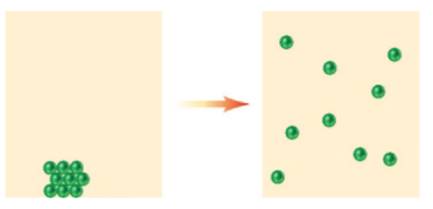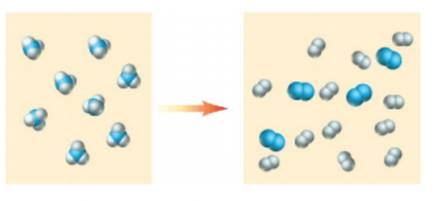
Introductory Chemistry: An Active Learning Approach
6th Edition
ISBN: 9781305079250
Author: Mark S. Cracolice, Ed Peters
Publisher: Cengage Learning
expand_more
expand_more
format_list_bulleted
Textbook Question
Chapter 2, Problem 2.3TC
Classify the following changes as chemical (C) or physical (P)
a) Baking bread
b) Grinding sugar into powder
c)

What type of change is represented in c.?
d)

What type of change is represented in d.?
Expert Solution & Answer
Want to see the full answer?
Check out a sample textbook solution
Students have asked these similar questions
Please answer the questions and provide detailed explanation. Please also include the Hydrogens that are on the molecule to show how many signals there are.
Capp aktiv.com
Part of Speech Table for Assi
x
Aktiv Learning App
K
Curved arrows are used to illustrate the flow of electrons. Using
the provided starting and product structures, draw the curved
electron-pushing arrows for the following reaction or
mechanistic step(s).
Be sure to account for all bond-breaking and bond-making
steps.
Problem 232 of 10
10:
Mg
Select to Add Arrows
Br
O
H
:0
CI:O
H
Mg
THE
+
dy
Undo
Reset Done
Br
Please answer the question and provide a detailed drawing of the structure. If there will not be a new C – C bond, then the box under the drawing area will be checked.
Will the following reaction make a molecule with a new C – C bond as its major product:
Draw the major organic product or products, if the reaction will work. Be sure you use wedge and dash bonds if necessary, for example to distinguish between major products with different stereochemistry.
Chapter 2 Solutions
Introductory Chemistry: An Active Learning Approach
Ch. 2 - Consider the photograph and illustrations of table...Ch. 2 - In the left box, draw a particulate-level...Ch. 2 - Classify the following changes as chemical C or...Ch. 2 - Specific gravity is a physical property. Beakers...Ch. 2 - Classify the following as homogenous or...Ch. 2 - Table salt from the beaker on the left in the...Ch. 2 - Which of the following are compounds, and which...Ch. 2 - Prob. 2.8TCCh. 2 - Identify the net electrical force-attraction,...Ch. 2 - aIs the process of boiling water exothermic or...
Ch. 2 - In everyday language, the term conserve usually...Ch. 2 - Write a brief description of the relationships...Ch. 2 - Write a brief description of the relationships...Ch. 2 - Prob. 3CLECh. 2 - Write a brief description of the relationships...Ch. 2 - Prob. 5CLECh. 2 - Prob. 6CLECh. 2 - Prob. 1ECh. 2 - Classify each of the following as macroscopic,...Ch. 2 - Suggest a reason for studying matter at the...Ch. 2 - How does a chemist think about particles that are...Ch. 2 - Using spheres to represent individual atoms,...Ch. 2 - Describe a piece of ice at the particulate level....Ch. 2 - 7.The word pour is commonly used in reference to...Ch. 2 - Prob. 8ECh. 2 - Which of the three states of matter is most easily...Ch. 2 - Compare the volumes occupied by the same sample of...Ch. 2 - Classify each of the following properties as...Ch. 2 - Classify the italicized property as chemical or...Ch. 2 - Which among the following are physical changes? a...Ch. 2 - Classify each of the following changes as chemical...Ch. 2 - Is the change illustrated below a physical change...Ch. 2 - Is the change in the illustration below a physical...Ch. 2 - Diamonds and graphite are two forms of carbon....Ch. 2 - Aspirin is a pure substance. If you had the choice...Ch. 2 - The substance in the glass below is from a kitchen...Ch. 2 - Are the contents of the bottle in the picture...Ch. 2 - Which of the following particulate illustrations...Ch. 2 - Which of the following particulate illustrations...Ch. 2 - Which of the following are pure substances and...Ch. 2 - Which of the substances below are pure and which...Ch. 2 - Apart from food, list five things in your home...Ch. 2 - Can the terms homogeneous and heterogeneous be...Ch. 2 - Which items in the following list are...Ch. 2 - Classify each of the following mixtures as either...Ch. 2 - Some ice cubes are homogeneous and some are...Ch. 2 - The freshly polished brass cylinder in the picture...Ch. 2 - Draw a particulate-level sketch of a heterogeneous...Ch. 2 - Draw a particulate-level sketch of a homogeneous...Ch. 2 - Suppose someone emptied ball bearings into a...Ch. 2 - Suggest at least two ways to separate ball...Ch. 2 - Prob. 35ECh. 2 - You receive a mixture of table salt and sand and...Ch. 2 - Classify the following as compounds or elements: a...Ch. 2 - Classify each of the following pure substances as...Ch. 2 - Which of the following are elements, and which are...Ch. 2 - Classify each of the following pure substances as...Ch. 2 - Classify each substance in the illustrations below...Ch. 2 - Does each of the particulate-level models below...Ch. 2 - a Which of the following substances would you...Ch. 2 - a Which of the following substances would you...Ch. 2 - Metal A dissolves in nitric acid solution. You can...Ch. 2 - A white, crystalline material that looks like...Ch. 2 - Questions 47 and 48: Samples of matter may be...Ch. 2 - Questions 47 and 48: Samples of matter may be...Ch. 2 - What is the main difference between electrostatic...Ch. 2 - Identify the net electrostatic force attraction,...Ch. 2 - Identify the reactants and products in the...Ch. 2 - In the following equation for a chemical reaction,...Ch. 2 - In the equation Ni+Cu(NO3)2Ni(NO3)2+Cu, which of...Ch. 2 - Write the formulas of the elements that are...Ch. 2 - Prob. 55ECh. 2 - Classify each of the following changes as...Ch. 2 - As a child plays on a swing, at what point in her...Ch. 2 - A bicycle accelerates from 5 miles per hour to 15...Ch. 2 - After solid limestone is heated, the rock that...Ch. 2 - Before electronic flashes were commonly used in...Ch. 2 - The photograph below shows a beaker of water and a...Ch. 2 - Prob. 62ECh. 2 - Prob. 63ECh. 2 - Prob. 64ECh. 2 - Distinguish precisely and in scientific terms the...Ch. 2 - Prob. 66ECh. 2 - A natural-food store advertises that no chemicals...Ch. 2 - Prob. 68ECh. 2 - Name some pure substances you have used today.Ch. 2 - How many homogeneous substances can you reach...Ch. 2 - Which of the following can be pure substances:...Ch. 2 - Can you have a mixture of two elements as well as...Ch. 2 - Can you have more than one compound made of the...Ch. 2 - Rainwater comes from the oceans. Is rainwater more...Ch. 2 - Prob. 75ECh. 2 - Prob. 76ECh. 2 - Consider the sample of matter in the illustration...Ch. 2 - A particulate-level illustration of the reaction...Ch. 2 - Prob. 79ECh. 2 - Prob. 80ECh. 2 - Prob. 81ECh. 2 - Prob. 82ECh. 2 - Particles in the illustration below undergo a...Ch. 2 - Prob. 84E
Knowledge Booster
Learn more about
Need a deep-dive on the concept behind this application? Look no further. Learn more about this topic, chemistry and related others by exploring similar questions and additional content below.Similar questions
- Please answer the question and provide a detailed drawing of the structure. If there will not be a new C – C bond, then the box under the drawing area will be checked. Will the following reaction make a molecule with a new C – C bond as its major product: Draw the major organic product or products, if the reaction will work. Be sure you use wedge and dash bonds if necessary, for example to distinguish between major products with different stereochemistry.arrow_forwardPlease do not use AI. AI cannot "see" the molecules properly, and it therefore gives the wrong answer while giving incorrect descriptions of the visual images we're looking at. All of these compounds would be produced (I think). In my book, I don't see any rules about yield in this case, like explaining that one product would be present in less yield for this reason or that reason. Please explain why some of these produce less yield than others.arrow_forwardPlease answer the question and provide detailed explanations.arrow_forward
- All of these compounds would be produced (I think). In my book, I don't see any rules about yield in this case, like explaining that one product would be present in less yield for this reason or that reason. Please explain why some of these produce less yield than others.arrow_forward5. Fill in the missing molecules in the following reaction pathway. TMSO Heat + CI then HF O₂N (1.0 equiv) AICI 3 OMearrow_forwarde. O₂N NO2 1. excess H2, Pd/C 2. excess NaNO2, HCI 3. excess CuCNarrow_forward
- Help with a periodic table task.' Procedure Part 1: Customizing a Periodic Table Use a textbook or other valid source to determine which elements are metals, nonmetals, metalloids (called semimetals in some texts), alkali metals, alkaline earth metals, transition metals, halogens, and noble gases. Download and print a copy of the Periodic Table of Elements. Use colored pencils, colorful highlighters, or computer drawing tools to devise a schematic for designating each of the following on the periodic table: Group numbers Period number Labels for these groups: alkali metals, alkaline earth metals, transition metals, inner transition metals (lanthanides and actinides), other metals, metalloids (semimetals), other nonmetals, halogens, and noble gases Metals, nonmetals, and metalloids Note: Write the group and period numbers and color/highlight each element for categorization. Be sure to include a key for the schematic. Take a photo of the completed periodic table and upload the…arrow_forwardDon't used hand raiting and don't used Ai solutionarrow_forwardCan you explain these two problems for mearrow_forward
arrow_back_ios
SEE MORE QUESTIONS
arrow_forward_ios
Recommended textbooks for you
 Chemistry for Engineering StudentsChemistryISBN:9781337398909Author:Lawrence S. Brown, Tom HolmePublisher:Cengage Learning
Chemistry for Engineering StudentsChemistryISBN:9781337398909Author:Lawrence S. Brown, Tom HolmePublisher:Cengage Learning Introductory Chemistry: An Active Learning Approa...ChemistryISBN:9781305079250Author:Mark S. Cracolice, Ed PetersPublisher:Cengage LearningChemistry: Matter and ChangeChemistryISBN:9780078746376Author:Dinah Zike, Laurel Dingrando, Nicholas Hainen, Cheryl WistromPublisher:Glencoe/McGraw-Hill School Pub Co
Introductory Chemistry: An Active Learning Approa...ChemistryISBN:9781305079250Author:Mark S. Cracolice, Ed PetersPublisher:Cengage LearningChemistry: Matter and ChangeChemistryISBN:9780078746376Author:Dinah Zike, Laurel Dingrando, Nicholas Hainen, Cheryl WistromPublisher:Glencoe/McGraw-Hill School Pub Co Chemistry: The Molecular ScienceChemistryISBN:9781285199047Author:John W. Moore, Conrad L. StanitskiPublisher:Cengage Learning
Chemistry: The Molecular ScienceChemistryISBN:9781285199047Author:John W. Moore, Conrad L. StanitskiPublisher:Cengage Learning Chemistry for Engineering StudentsChemistryISBN:9781285199023Author:Lawrence S. Brown, Tom HolmePublisher:Cengage Learning
Chemistry for Engineering StudentsChemistryISBN:9781285199023Author:Lawrence S. Brown, Tom HolmePublisher:Cengage Learning

Chemistry for Engineering Students
Chemistry
ISBN:9781337398909
Author:Lawrence S. Brown, Tom Holme
Publisher:Cengage Learning

Introductory Chemistry: An Active Learning Approa...
Chemistry
ISBN:9781305079250
Author:Mark S. Cracolice, Ed Peters
Publisher:Cengage Learning

Chemistry: Matter and Change
Chemistry
ISBN:9780078746376
Author:Dinah Zike, Laurel Dingrando, Nicholas Hainen, Cheryl Wistrom
Publisher:Glencoe/McGraw-Hill School Pub Co

Chemistry: The Molecular Science
Chemistry
ISBN:9781285199047
Author:John W. Moore, Conrad L. Stanitski
Publisher:Cengage Learning

Chemistry for Engineering Students
Chemistry
ISBN:9781285199023
Author:Lawrence S. Brown, Tom Holme
Publisher:Cengage Learning

What are CHNOPS? These Chemical Elements = 98% of Life | Biology | Biochemistry; Author: Socratica;https://www.youtube.com/watch?v=w90wFlR53VM;License: Standard YouTube License, CC-BY